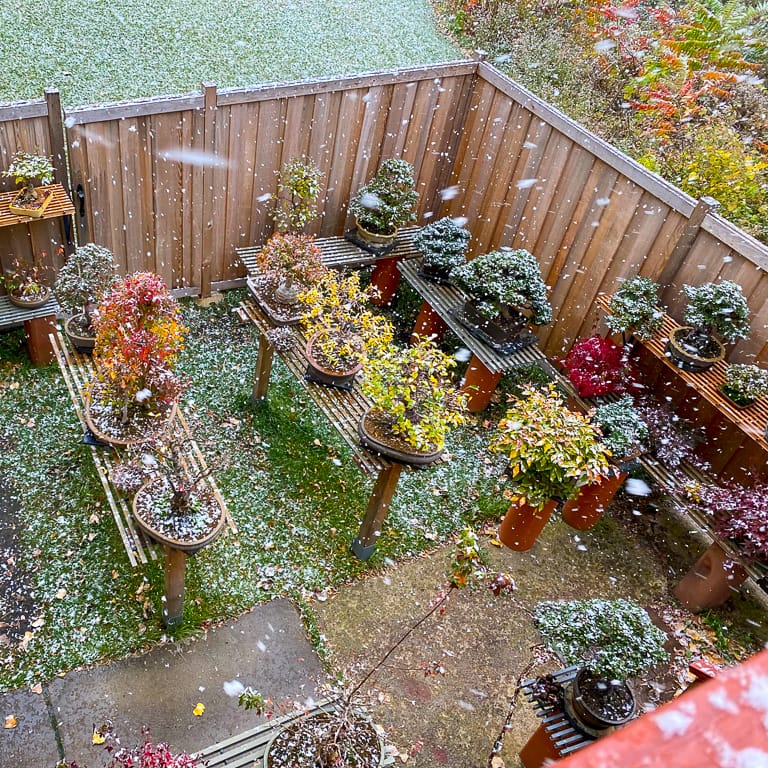Thanks entirely to reader contributions, I’ve published a guide to caring for bonsai in winter.

Early snowfall (photo courtesy Jeff in Minnesota)
Topics include:
- Tropical bonsai winter care
- Plant hardiness
- Preparing bonsai for winter storage
- Winter storage strategies
- Spring care: removing trees from winter storage
- Winter routines from around North America
- Helpful links
I’ve tried to make the guide as complete as possible, but if you have more to say on the topic, let me know in the comments below and I’ll make updates as appropriate.
A big THANK YOU to everyone who contributed suggestions and photos. I’m amazed and impressed by your creativity and passion for growing bonsai in cold climates, and I’m looking forward to thanking you in person as soon as we get the chance!
You can check out the guide at the link below:
Winter care for bonsai
Subscribe to Bonsai Tonight
New Posts Delivered Every Tuesday and Friday
steve perea says
I’m just north of Seattle, I created a hoop house with 10′ 1/2″ PVC covered with plastic film and loose zip ties slid over 12″ rebar staked in the ground. I can pull up the sides to control moisture (block rain) or slide off completely on a sunny day, I put an electric heater in when the temps were teens for a week, all trees did great, mostly conifers, maples went in the garage. also added black jugs of water to moderate temps.
Jonas Dupuich says
Thanks Steve! The convertible sides are a great feature – I’d like a structure like that in my garden too!
Omar says
Thanks Jonas! I moved from SoCal to NY after getting into the hobby, so there is a lot here I had to learn by trial and error.
One thing I tried was making a dug-in cold frame, digging down about 18 inches, not quite to the frost line (36-48″) but closer. Trees could go in and pots get mulched over. I tracked it with some temperature meters and with the bioactivity going on in the mulch, it was always above freezing, even when outside temps were in the single digits.
Re: elms, a Catlin elm I had survived two winters in an unheated protected space, but I lost it on the third winter, which had a few particularly harsh cold snaps. I think that, at least in our 7a-7b zone, elms need to be brought in late December until March, although admittedly this is coming from little experience. Would love to hear what others think.
Jonas Dupuich says
Thanks Omar – I’ll be curious to hear what others have experienced too!
Lars Grimm says
Hi Jonas,
Great information as always. I am still confused about top dressing. Do you recommend removing top dressings of shredded sphagnum completely or just replacing it for winter? I have heard people advocate removing completely as they can be a source of overwintering for pests. However, replacing this with mulch or straw could have the same effect. In contrast, that top dressing (mulch, straw, or sphagnum) provides insulation, especially to shallow tender roots. Fungus is a major problem in my area so I would rather err on the side of being overly cautious.
Jonas Dupuich says
I’d recommend removing it rather than replacing it as I’d expect to replace it again in spring or after a repot. Since fungus is a problem in your area, I’d try to avoid retaining extra moisture. That said, I’d like to hear from people who have experience overwintering with and without top dressings.
Ron skibbens says
Hi Jonas,
I’m in Nova Scotia (zone 6b) and wonder if my overwintering system is a reason I’ve had no luck getting my apple, quince, chestnut or linden to flower. Every fall, I take them out of their pots and sink them to ground level or slightly deeper in my vegetable garden. As I put them in the ground, I flood the hole with water and them heavily water again after tamping the soil around the root ball. I mulch heavily with straw and leaves and with Christmas tree boughs after the holiday. I’ve lost a few branches to ice storms but overall have good luck keeping the trees alive. However, none of these mentioned above have flowered in the past 5 years or so. Any suggestions?
All the best, Ron
Jonas Dupuich says
Hi Ron – good question about the flowering trees. I’d be curious if others in your area have experienced this because nothing obvious is coming to mind. If the trees typically do well in your zone and they’re healthy and receiving adequate sunlight and fertilizer during the growing season, I can’t think of likely culprits.
Typically a lack of dormancy, sunlight, or fertilizer are to blame, but it doesn’t seem like this is the case. I’d also be curious if the flower buds are damaged in winter or if they’re not setting at all (it sounds like the latter).
Soil-wise, I don’t know that it’s necessary to tamp the soil so firmly as air is a great insulator. Am curious if the trees are all otherwise healthy.